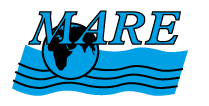A program of the Lawrence Hall of Science that seeks to increase ocean literacy through informal and formal education initiatives
A Field Guide to Seashores Coloring Book
This coloring book shows all the most common seashore habitats from Maine to California. Children can learn about sea life with these scientifically accurate illustrations.
A Gift From the Sea
A boy picks up a rock that he finds on the beach. He holds it in his hand, and admires it. He doesn't know that the rock has been on a great journey through time in making its way to him: that it was spewed forth from a fiery volcano, then altered by eons of wind and rain, frozen during the ice age, and finally carried out into the ocean, where it lay on the floor of the sea before being thrust onto the shore at his feet. But he does know that it is a gift from the sea.
At The Beach
With help from delightful paper cut pictures, the story is told of a mother who draws Chinese characters in the sand for her young son. She explains how the shape of the characters is related to their meaning. As the characters are described, borders and background scenes help illustrate the meaning as well as show the life and activities that occur on a beach. Included is a list of all the characters and their pronunciation.
Baby Whales Drink Milk
The title epitomizes Esbensen’s creative presentation of an important concept: how whales differ from the fish they seem to resemble and share characteristics with other mammals. Introduces a full range of information about whale anatomy, development, and behavior. Esbensen’s simple, informative text keeps its young audience clearly in view.
Brown Pelican at the Pond
Written by a child, this simple story tells of a boy and his friends, who on a visit to a pond, find an injured pelican, take it to a vet, then nurse it back to health. The boy then returns it to the pond "because he belonged with other pelicans." Can be the start of a classroom discussion on understanding the needs of animals.
Chelonia: Return of the Sea Turtle
This is Sea Challengers' first children's book. The well-known artist and the two co-authors have produced a beautiful, entertaining and informative book based on a true event. The story describes the rescue, recovery and eventual return to the wild of a young green sea turtle off Baja California by a young girl and her father.
Dolphin Talk: Whistles, Clicks, and Clapping Jaws
Dolphins are smart. They are so smart that they can talk to each other. Dolphins communicate underwater for the same reason people talk on land: to let others know who they are, where they are, and maybe even how to feel. Also included are activities that explore how dolphins talk to each other.
Famous Seaweed Soup
In her first book, Martin structures a family visit to the beach around a clever inversion of ``The Little Red Hen.'' Nobody helps Sara make her soup of seaweed (two kinds), snails, and ``smelly stuff'' from a beachcombing--her parents are busy putting on sunscreen, fixing lunch, taking care of the baby, or reading. Sara doesn't mind at all; she stirs up her concoction with a feather and exacts her penalty: those who didn't help must eat it! Which they cheerfully do, with much slurping and, presumably, little swallowing.
Follow Me!
This is a very gentle story of a young sea lion who follows a crab traveling along the rocks. It can support or spawn discussions of animals and their habitats. Another excellent use of this book is for sheltered instruction. Since the book is wordless, the students themselves can write the story—in the language of their choice.
Handbook of Sandy Beach Organisms
Handbook of Sandy Beach Organisms is a reference book about sandy beach organisms. A different animal is described in detail on each page. The book is organized by type of organism, so there is a page of information about organisms that share something in common. For example, pages of information about sanderlings, herring gulls, and peregrine falcons follow the page titled Birds. This book provides students with a second source of information for their organism reports.
Pages




